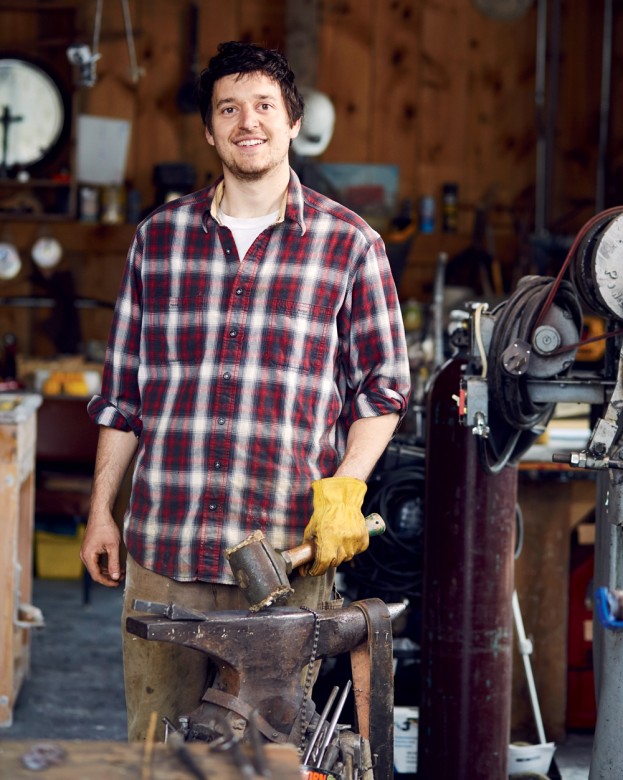In the Blacksmith Shop with Nick Moreau | Open Studio
Passed down through three generations, heirloom tools keep a family tradition alive.

Nick Moreau at work in Woodbridge, Connecticut. “The heart and soul of blacksmithing is the anvil work and hammering,” he says. “There’s so much beauty in the process.”
Photo Credit : Pat Piasecki
Photo Credit : Pat Piasecki
Fire, heat, tools, noise—it’s like a guy’s dream,” grins Nicholas Wicks Moreau, a Connecticut blacksmith, surrounded by the fruits of this conflagration: music stands twined with metal ivy, a nicely proportioned garden gate, a massive chandelier.
For the past year, Nick, 28, has worked side by side with his friend, potter Trevor Youngberg, in Youngberg’s barn, which Nick helped raise. But the road here—to this post-and-beam beauty in Woodbridge—has been circuitous and curving, not unlike the graceful bottle opener he bangs out while we talk, later imprinting it with the Wicks Forge stamp.
“It was a humbling experience, too,” Nick says, leaning into his great-grand-father’s anvil. “I’d never been so bad at something for so long.”
Though he never knew his great-grandfather, who started Wicks Welding in the 1920s, “there was always a picture of him, working on the pylons for the World’s Fair, in my grandfather’s house in Queens,” Nick remembers. When the family operation moved to Danbury, Connecticut, the next generation continued welding. And when his grandfather, Edward, retired, the tools retired, too—to his grandparents’ garage.
Meanwhile, the arts were slumbering in Nick’s blood: His mother is an artist; his grandfather also repaired violins and cellos; and Nick loved pottery and carpentry. But he’d never worked with metal. “My background is construction,” he notes. “So I like things to be artistic and functional—bringing beauty to handmade objects that are used every day.”
In 2011, while in Scotland studying for his master’s in ecological economics, he decided to hunt up a blacksmith. “I wanted to have an artistic experience,” he explains. “Blacksmithing is still ingrained in the consciousness there. They’re still listed in the Yellow Pages.” And sure enough, there it was: The Blazing Blacksmith. “The bus dropped me off in the middle of nowhere, and here was this rustic shop, tools everywhere, and I knew instantly this was where I wanted to be.”
“I don’t work with anyone,” Jim Whitson, a master blacksmith, told Nick politely, and then offered him a cup of tea. A week later, Jim changed his mind, and Nick became his apprentice in a 3-D environment of hand-forged gates, furniture, railings, and sculptures. “It was unlike anything I’d ever seen before,” he marvels. Jim started him making 130 ivy leaves for a work-in-progress gate, cutting and grinding each leaf, tooling it for veins, making up to 300 hammer hits per cutout. Then Nick forged his own first item: an ivy-leaf fire poker.

A hand-forged music stand is enhanced with graceful tendrils.
Photo Credit : Pat Piasecki
“The heart and soul of blacksmithing is the anvil work and hammering,” he says. “When you start, you’re constantly adjusting how and when you hit, angling the hammer, angling the poker, and if you don’t have that down, you won’t do it properly. Apprenticing was great—I got to put in all that repetition, and see how a master approached his craft. Jim is an artist and a craftsman. And he was really patient; by the end of the year I was doing more complex things.”
When Nick returned to the U.S. and opened his grandfather’s garage, “I could recognize every tool in there” for the first time. But what really motivated him was when someone else offered to clear out his grand-father’s equipment: “That’s when I said, ‘I want your tools, I want them in our family, and I want to use them.’” Nick researched and fabricated his own forge, set up his water bucket, and started making a few little things to sell online, working out of the garage. Word of mouth, his photo on the June 2015 cover of Popular Mechanics for a story about the new generation of “makers,” and growing recognition have led to larger commissions.
Blacksmithing is all of those things that Nick described early on: an elemental synthesis of earth, air, fire, water, and noise. Sparks fly; there’s a rhythmic, timeless clanging that feels as though it bridges the ages; and metal heated up in a 1400° forge and plunged into water practically spits—you can almost hear it exhale.
Nick sets up a rhythm, flattening the metal against this anvil that’s like a noble, battered old boxer: “I like using my hands, turning raw materials into something you use. Back in the day, that’s what blacksmiths did. No one’s doing it because it’s lucrative but because there’s a passion and a love for it. There’s so much beauty in the process.” He hands me a sinuously curved bottle opener. “Most of my tools are older than both of us put together,” Nick smiles. “They have a life of their own … I think that’s pretty cool.”
Prices range from $7 for a bottle opener to $100+ for custom furniture to $1,000+ for a custom gate or railing. 203-873-8778; wicksforge.com; wicksforge@gmail.com
Annie Graves
A New Hampshire native, Annie has been a writer and editor for over 25 years, while also composing music and writing young adult novels.
More by Annie Graves

